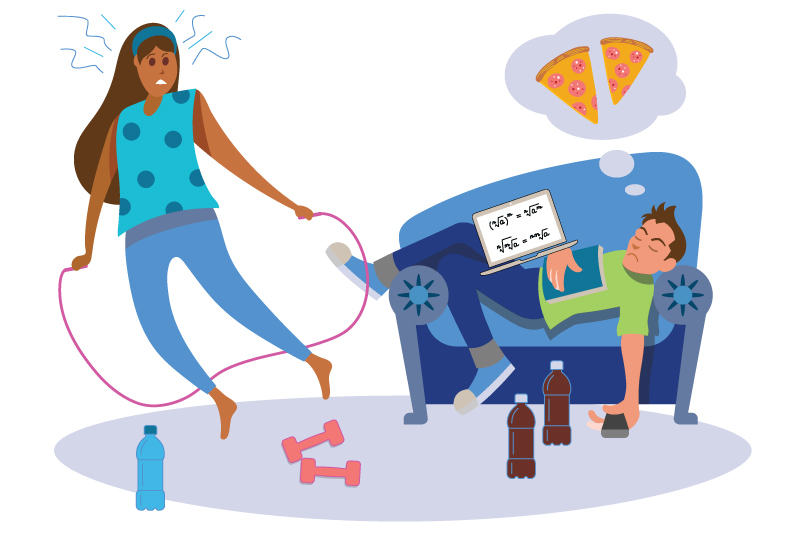Eating disorders in the time of COVID: Advice for parents

As the COVID-19 pandemic has worn on, it has led to a secondary epidemic of eating disorders among children and teens. In January, the National Eating Disorders Association reported a spike of activity on its help lines. And treatment programs are having trouble keeping up with the requests.
“We have seen a huge increase in new-onset eating disorders in our teen population here in Boston and in talking with our colleagues nationally,” says adolescent medicine physician Dr. Tracy Richmond, who directs the Eating Disorders Program at Boston Children’s Hospital. “Outpatient care centers are receiving at least twice as many requests as pre-pandemic, and our inpatient program has three to four times more adolescents than last year.”
We reached out to Dr. Richmond to better understand the reasons for the uptick and how parents can help teens who are struggling with or showing signs of an eating disorder.
Why have eating disorders increased during the pandemic?
Being stuck at home has increased kids’ anxiety and amplified any vulnerability to overeating or undereating. Teens are supposed to be becoming independent and prioritizing peer relationships. But until recently the pandemic has kept them home with their parents, and many are opting to stay home for the rest of the school year, or until they are vaccinated. The lack of structure and contact with friends have been a challenge, and teens are using disordered eating as way to cope with the stress.
There also are fewer “guard rails” on kids’ eating and exercise patterns. At school, it may be harder for kids to avoid eating for long because there are more cues in their environment, more peer influence, and more adult eyes on them.
At the same time, kids are relying on social media for connection more than ever and are being inundated with messages. These include messages on how not to gain the “quarantine 15” or how to use more time at home to engage in fitness challenges.
What kinds of eating disorders are you seeing?
Our clinic is seeing both restrictive eating (avoiding eating or refusing to eat certain foods) and binge eating (eating a lot of food at once). Binge eating has flared, likely because of less structure in kids’ lives and more constant access to food at home.
Anorexia nervosa has also increased, due to in part to increased anxiety and fewer social interactions. We’re seeing more severely disordered eating and very rapid decreases in weight. Some kids have lost 20, 40, or as much as 70 to 80 lbs. over the course of the pandemic.
We’re seeing all genders. While more white preteens and teens present for care, we’re seeing disordered eating in Black and Latinx kids too. I’ve also been surprised by how young some of our patients are. We have seen 10-, 11-, and 12-year-olds with very significant weight loss.
We’re also seeing kids getting too much exercise. Many are watching TikTok workout videos and becoming obsessed with exercise, especially kids who have had to stop playing school sports. Without the guidance they would get through physical activity programs at school or through sports, kids may do much longer workouts than they should — like two hours or more. We are hearing stories of kids being bored and doing three or four workouts in a day or taking two-hour walks.
We also see children with avoidant restrictive food intake disorder, which involves highly selective eating habits, low appetite, or worries about choking or some other consequence to eating. These children aren’t worried about their body shape or size, but tend to have a lot of underlying anxiety. Some have done worse during COVID-19 because of anxiety. Others have done better because they feel more control at home, and parents can provide more structure and encouragement to eat.
What should parents be doing?
Be alert to significant changes in your teen’s exercise and eating habits, and address the problem directly. Ask what’s going on. Be concerned if your child is attaching a lot of significance to their weight or body shape, or attaching self-value to how much they’ve eaten or exercised. Many teens haven’t been getting dressed for virtual school and instead wear the same baggy clothes every day, which can make weight loss less obvious.
Some specific advice:
- Don’t allow your teen to totally isolate themselves. Increased withdrawal from family and peers is a worrisome sign. Have family meals and frequent touchpoints to see how things are going, acknowledging that things are not normal. It’s important to bring teens into the family discourse and family events.
- Try to establish three meals a day, with two to three snacks. Kids should be eating with their family when possible. Be wary if your child is avoiding or cutting out whole food groups, such as carbohydrates, or are overly mindful of things like added sugars.
- Limit exercise to a reasonable amount. Be concerned if they express worry about missing a day of exercise or fitting in their workout, or if they can’t relax until their workouts are done. If your teen is structuring their day around exercise, that is a red flag.
- Seek professional help. Our patients have adapted really well to virtual visits. We often partner with primary care offices across the state, allowing kids to get their weight and vitals done locally and then engage with our specialists via telehealth.
Learn more about the Eating Disorders Program at Boston Children’s Hospital.
Related Posts :
-

Help your child manage anxiety about school violence
With news of school shootings and other violence often reaching children, parents sometimes grapple with how to help their child ...
-

Partnering diet and intestinal microbes to protect against GI disease
Despite being an everyday necessity, nutrition is something of a black box. We know that many plant-based foods are good ...
-

Are weight-loss medications and surgery right for teens?
Advances in bariatric surgery and weight-loss medications have made weight management accessible to more adults. But are these approaches effective — ...
-

Addressing food insecurity and nutrition challenges in pediatric type 1 diabetes care
Managing type 1 diabetes can be overwhelming for children and families. As children learn to live with the disease, many cut ...





